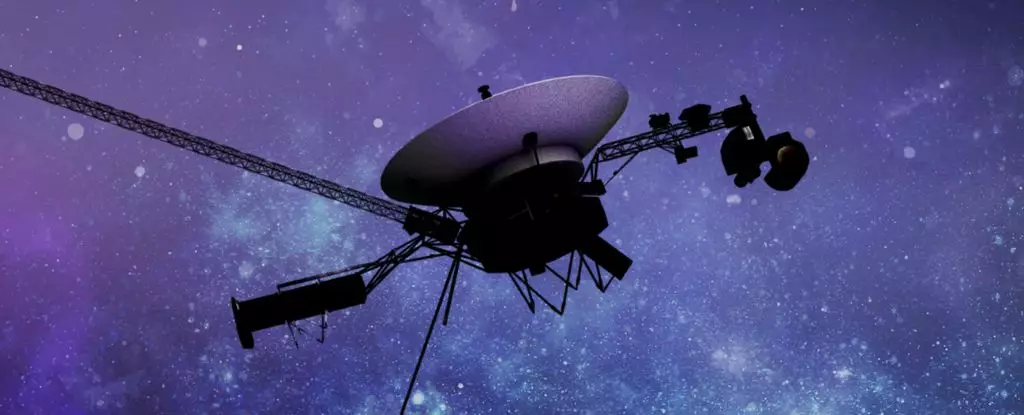The Voyager 1 spacecraft, a true testament to human ingenuity and the quest for exploration, experienced an unexpected communication blackout from its distant post in the interstellar void last month. This unanticipated event provided a unique window into the complexities and challenges of long-distance space exploration, particularly as the spacecraft traverses a region of space no human-made object has encountered before. What transpired during this period was not just a technical glitch but also a narrative that showcases the precarious nature of relying on technology that is nearing the half-century mark.
The saga began on October 16, when NASA sent out a seemingly innocuous command to Voyager 1, instructing it to activate one of its heaters. Unfortunately, after this transmission, the spacecraft went silent, neglecting to respond to any further communications from Earth. It quickly became apparent that something had gone wrong, though it took NASA nearly 48 hours to realize the probe had ceased its usual signals. This delay can be attributed to Voyager 1’s extreme distance of nearly 25 billion kilometers (15.3 billion miles) from Earth, a distance that translates into a signal travel time of approximately 23 hours one way. Thus, the lagging communication frame of reference adds layers of complexity to resolving issues with the spacecraft.
When the Deep Space Network (DSN) finally managed to reacquire contact with the Voyager 1 signal on October 18, it became evident that the spacecraft had shifted to an unexpected transmission frequency. This anomaly indicated that Voyager 1’s internal fault protection mechanisms had been triggered, intelligently shutting down its main systems to conserve power after a heater draw unexpectedly exhausted operational limits. Consequently, the critical X-band radio transmitter, which serves as Voyager’s primary line of communication with Earth, was turned off to redirect power elsewhere. Such automated adjustments, although remarkable, reveal the fragility of systems that are relied upon for communication across the vast depths of space.
Following the initial restoration of communication, engineers at NASA noted a disconcerting pattern: the spacecraft entirely lost its signals the very next day. It appeared that the fault protection had activated again, which had led Voyager 1 to switch to the S-band transmitter to manage energy consumption. The inherent risk in this situation is that the S-band signal is significantly weaker than the X-band, raising concerns about the probe’s detectability at such great distances. The last time Voyager communicated via S-band was in 1981, when it was much closer to us — thereby complicating the recovery process.
Fortunately, on October 22, engineers successfully tested the S-band transmitter and confirmed it was operational. Nevertheless, they remain hesitant to turn the X-band transmitter back on until a full understanding of the issue is reached. This cautious approach underscores the balance that must be maintained when dealing with aging technology that is operating far beyond its designed lifetime, indeed teetering at the edge of functionality.
This brief episode highlights some of the larger issues concerning spacecraft that have been in service for nearly five decades. Voyager 1’s age means that it is increasingly susceptible to technical malfunctions. Just last year, a critical glitch resulted in the spacecraft transmitting what could only be described as scrambled telemetry data for several months, demonstrating the kind of vulnerabilities that can arise as systems deteriorate over time. These concerns are compounded by the expectation that both Voyager probes will cease to provide scientific data after 2025 due to decreased power generation.
As they drift further into the realms of interstellar space, both Voyager 1 and its twin, Voyager 2, are passing through an uncharted territory where discoveries about cosmic radiation and magnetic fields continue to unfold. Their current trajectory indicates that within approximately 40,000 years, they will come within two light-years of neighboring stars, a fascinating glimpse into the future of humanity’s manufactured ambassadors.
Legacy of Exploration
In an age where technology sometimes appears ephemeral, the story of Voyager 1 serves to remind us of the durability of human achievement. As these spacecraft press on into the darkness, their journey is much more than a solitary voyage through space; it is emblematic of the enduring spirit of exploration that drives human curiosity. Eventually, even after they lose contact with Earth, the Voyagers will continue their cosmic travel, embodying the remnants of human culture— a testament to our quest for knowledge and understanding in the face of infinity.


Leave a Reply